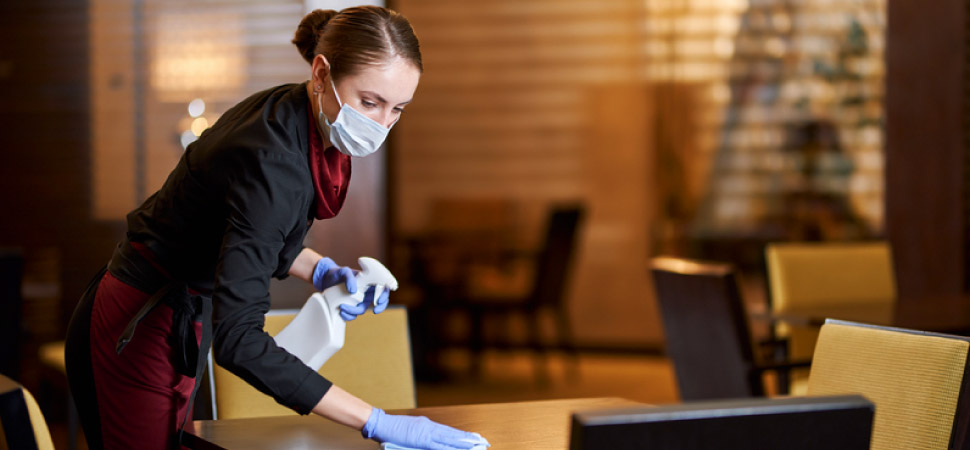
What a relief! For the first time in well over a year, now fully vaccinated, I was able to walk into a store and dine in a restaurant without a mask. Like many others, I felt like I was emerging from a cave. I had forgotten how great it was to see people smiling with their mouths and not just their eyes.
I also had forgotten how easy it is to catch a cold, something I had not done in the past year but managed to do in the first week of going mask-less.
What this pointed out to me wasn’t that we should all wear masks for the rest of our lives. Instead, it reminded me that while the worst of the COVID-19 pandemic may be behind us, this is no time for commercial facilities to let down their guard on infection prevention.
The High Price of Easing Up
We can’t forget the whole spectrum of highly infectious germs that are not COVID 19-related—from those that cause the common cold and the flu to MRSA, E. coli, Ebola, SARS… the list is endless. Besides the health risks, these pathogens present a host of challenges in the workplace, including:
- Employee absenteeism
- Additional training of substitute workers
- Increased building occupant stress and anxiety
- Low staff morale
- Higher employee turnover
- Poor customer service
- Reduced productivity
All these can negatively impact a company’s revenues and narrow its profit margins.
Recently, the CDC issued updated guidelines for cleaning and disinfecting, which some people considered a reversal of its previous stance. Some read it as a call to clean only and not to disinfect. In reality, the agency was clarifying what it had been saying all along: that successful infection-prevention procedures call for cleaning first, then, when warranted, responsible disinfecting. The keyword is responsible.
Spraying disinfectant willy-nilly into the air or using a fogger to cover outdoor areas where disinfectant is not needed are examples of irresponsible disinfecting. In the United States, all disinfectants must be registered with the EPA as pesticides. This is because they are chemicals—chemicals that, when misused, present health risks to people and the environment. However, not disinfecting responsibly in commercial spaces or failing to disinfect high-touch surfaces used by multiple people exposes building occupants to health threats.
“In commercial settings, such as a mall, office, hospital, etc., we are constantly exposed to various foreign organisms,” says Michael Diamond, co-founder of The Infection Prevention Strategy (TIPS). “The risk of contracting an infection in a commercial setting is not the same as within the bubble of a household. It is imperative to adhere to proper cleaning and disinfection protocols. It is irresponsible to simply clean and not disinfect in a public setting.”
The Wrong Equipment
Sometimes the line between responsible and irresponsible disinfecting comes down to the equipment used. Consider some of the devices that seemed to pop up out of nowhere during the pandemic, without scientific backing or data, such as:
- Disinfecting or “sanitizing” tunnels that cover people with a disinfectant mist
- UV light devices delivering radiation of unspecified intensities
- Surface coatings purported to disinfect for up to seven days, without mention of the potential impact of conditions such as temperature, humidity, and surface usage
- Microbial sprays that promise 24-hour protection from COVID-19 without mentioning the word “virus”—even in the small print
- Foggers that spray disinfectant everywhere in hopes of it landing where it is needed.
Some of these innovations may well disinfect as promised. But at what potential cost to human health, the environment, and even our bottom lines?
The Right Equipment
Just as there are some types of equipment that should never be used to disinfect, there is equipment that can make disinfecting safer. Two that come immediately to mind are:
Wipes. Disinfectant wipes apply the disinfectant directly to the targeted area, whether to the hands or to a surface. They do not allow the disinfectant to become airborne, which can cause respiratory irritation and allows the disinfectant to land on surfaces needlessly. Wipes also are safer in that they do not require the mixing of potentially harmful chemicals. They reduce chemical product waste and can be applied on an as-needed basis. They also allow building occupants to feel more confident and in control when it comes to infection prevention.
Electrostatic Sprayers. Based on the scientific fact that opposites attract, electrostatic sprayers apply a positive charge to disinfectant droplets so that they are attracted to negatively-charged surfaces. This technology is safer for workers and building occupants as it prevents disinfectants from becoming airborne. It also prevents product waste: surfaces that have already been disinfected will repel additional disinfectant so that it automatically adheres to the next bare surface. This technology also allows more thorough coverage, including of hard-to-reach places, such as the underside of surfaces, and rounded objects, such as chair and table legs.
Do you need supplies to keep your facility and your workers, customers, and other building occupants safe and healthy? Visit us at www.sanitizersplus.com to order your top-grade, affordable infection prevention supplies. Not sure what you need? No problem! Our experienced staff is waiting to help! Just call 800-253-3500 or visit www.sanitizersplus.com to chat with us online.